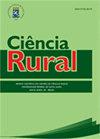Proximal hyperspectral analysis in grape leaves for region and variety identification
IF 0.9
4区 农林科学
Q3 AGRONOMY
引用次数: 0
Abstract
ABSTRACT: Reflectance measurements of plants of the same species can produce sets of data with differences between spectra, due to factors that can be external to the plant, like the environment where the plant grows, and to internal factors, for measurements of different varieties. This paper reports results of the analysis of radiometric measurements performed on leaves of vines of several grape varieties and on several sites. The objective of the research was, after the application of techniques of dimensionality reduction for the definition of the most relevant wavelengths, to evaluate four machine learning models applied to the observational sample aiming to discriminate classes of region and variety in vineyards. The tested machine learning classification models were Canonical Discrimination Analysis (CDA), Light Gradient Boosting Machine (LGBM), Random Forest (RF), and Support Vector Machine (SVM). From the results, we reported that the LGBM model obtained better accuracy in spectral discrimination by region, with a value the 0.93, followed by the RF model. Regarding the discrimination between grape varieties, these two models also achieved better results, with accuracies of 0.88 and 0.89. The wavelengths more relevant for discrimination were at ultraviolet, followed by those at blue and green spectral regions. This research pointed toward the importance of defining the wavelengths more relevant to the characterization of the reflectance spectra of leaves of grape varieties and revealed the effective capability of discriminating vineyards by their region or grape variety, using machine learning models.葡萄叶片近端高光谱分析用于区域和品种鉴定
摘要:由于植物生长环境等外部因素和植物内部因素的影响,同一物种植物的反射率测量结果可能会产生不同光谱的数据集。本文报道了对几个葡萄品种和几个地点的葡萄藤叶片进行辐射测量分析的结果。研究的目的是,在应用降维技术来定义最相关的波长后,评估应用于观测样本的四种机器学习模型,旨在区分葡萄园的地区和品种。测试的机器学习分类模型有典型判别分析(CDA)、光梯度增强机(LGBM)、随机森林(RF)和支持向量机(SVM)。从结果来看,LGBM模型在光谱区域识别方面的精度较高,为0.93,其次是RF模型。对于葡萄品种的区分,这两种模型也取得了较好的结果,准确率分别为0.88和0.89。与识别更相关的波长是紫外线,其次是蓝色和绿色光谱区域。该研究指出了定义与葡萄品种叶片反射光谱特征更相关的波长的重要性,并揭示了使用机器学习模型根据地区或葡萄品种区分葡萄园的有效能力。
本文章由计算机程序翻译,如有差异,请以英文原文为准。
求助全文
约1分钟内获得全文
求助全文
来源期刊

Ciencia Rural
AGRONOMY-
CiteScore
1.70
自引率
0.00%
发文量
233
审稿时长
2-4 weeks
期刊介绍:
The purpose of Ciência Rural is to publish the results of original research, note and reviews which contribute significantly to knowledge in Agricultural Sciences. Preference will be given to original articles that develop news concepts or experimental approaches and are not merely repositories of scientific data. The decison of acceptance for publication lies with the Editors and is based on the recommendations of Editorial Comission, Area Committee and/ or ad hoc reviewers. The editors and reviewers are external to the institution.
 求助内容:
求助内容: 应助结果提醒方式:
应助结果提醒方式:


